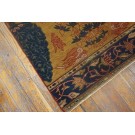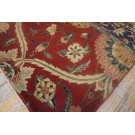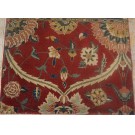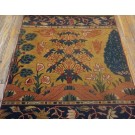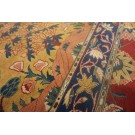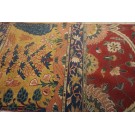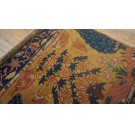Early 20th Century N. Indian Lahore Sampler
Indian Sampler Mat
Northern India, possibly Lahore
All cotton foundation, with approx.. 180 asymmetric (Persian) wool knots per square inch
Sampler mats were created for several different purposes: top store patterns; for the weavers to consult when making larger carpets; and for the ultimate client to approve the weave, colorway and pattern before a larger carpet is woven. Indian samplers are quite rare, and they usually function as both weaver guides and pattern reservoirs. This sampler, incorporating a snippet of the ogival red leaf lattice field, with a section of a yellow ochre border with cypresses, trees and upright flowering plants , has not been taken from a Mughal period pashmina pile, silk foundation, ultra-fine weave but from an illustration of one. A fragmentary piece is in the Metropolitan Museum of Art, Ex-Altman collection. These fragments are from a long and narrow carpet with a weave of about 1250 knots per square inch. They were first published with an illustration Sarre and Trenkwald, Old Oriental Carpets, vol. II, 1926-1929. So, the sampler mat cannot be older than about 1930. The pile is regular sheep wool rather than fine pashmina goat. The sampler was used in a factory to create a full-sized carpet. Given that it is incomplete in both field and border, there were probably additional samplers with other parts of the design. The colors are, however, modern close approximations of the original. As to where and by whom the ampler was made. Lahore is the first possibility. This has always been a carpet trading and weaving center. Thus, the rug could have been ordered from any oner of the local, shops. The sampler was made in a very professional atelier which had access to an extensive design library, one having the Sarre and Trenckwald set. O.C.M. (Oriental Carpet Manufacturers) was active in India beginning in the first quarter of the 20th century and had an excellent library and skilled designers. They had a specialized factory in Mirzapur weaving fine carpets and this sampler could have been used these. OCM did not market their carpets and it is difficult to assign any extant pieces to them, but since they were by far the largest carpet manufacturer, it is quite possible that this piece is one of theirs. Historicising Mughal-style carpets, copied from illustrations in Sarre and Trenkwald , and from Hendley, Carpets in the Jaipur Palaces, 1905-6, were available in the Interwar Period, OCM possessed them in their extensive library, and we have seen other Mughal-style pieces of finer weave that successfully reproduce the originals. This sampler allows us to complete the fragmentary original. -
Northern India, possibly Lahore
All cotton foundation, with approx.. 180 asymmetric (Persian) wool knots per square inch
Sampler mats were created for several different purposes: top store patterns; for the weavers to consult when making larger carpets; and for the ultimate client to approve the weave, colorway and pattern before a larger carpet is woven. Indian samplers are quite rare, and they usually function as both weaver guides and pattern reservoirs. This sampler, incorporating a snippet of the ogival red leaf lattice field, with a section of a yellow ochre border with cypresses, trees and upright flowering plants , has not been taken from a Mughal period pashmina pile, silk foundation, ultra-fine weave but from an illustration of one. A fragmentary piece is in the Metropolitan Museum of Art, Ex-Altman collection. These fragments are from a long and narrow carpet with a weave of about 1250 knots per square inch. They were first published with an illustration Sarre and Trenkwald, Old Oriental Carpets, vol. II, 1926-1929. So, the sampler mat cannot be older than about 1930. The pile is regular sheep wool rather than fine pashmina goat. The sampler was used in a factory to create a full-sized carpet. Given that it is incomplete in both field and border, there were probably additional samplers with other parts of the design. The colors are, however, modern close approximations of the original. As to where and by whom the ampler was made. Lahore is the first possibility. This has always been a carpet trading and weaving center. Thus, the rug could have been ordered from any oner of the local, shops. The sampler was made in a very professional atelier which had access to an extensive design library, one having the Sarre and Trenckwald set. O.C.M. (Oriental Carpet Manufacturers) was active in India beginning in the first quarter of the 20th century and had an excellent library and skilled designers. They had a specialized factory in Mirzapur weaving fine carpets and this sampler could have been used these. OCM did not market their carpets and it is difficult to assign any extant pieces to them, but since they were by far the largest carpet manufacturer, it is quite possible that this piece is one of theirs. Historicising Mughal-style carpets, copied from illustrations in Sarre and Trenkwald , and from Hendley, Carpets in the Jaipur Palaces, 1905-6, were available in the Interwar Period, OCM possessed them in their extensive library, and we have seen other Mughal-style pieces of finer weave that successfully reproduce the originals. This sampler allows us to complete the fragmentary original. -
| Stock ID: | #25670 |
| General Rug Type: | Indian |
| Specific Rug Type: | Lahore |
| Circa: | 1930 |
| Ground Color: | Red |
| Border Color: | Gold |
| Origin: | India |
| Material: | Wool |
| Weave: | Pile - Knotted |
| Shape: | Rectangle |
| Width: | 2' ( 61 cm ) |
| Length: | 3' 10" ( 117 cm ) |
| Tearsheet Download |



